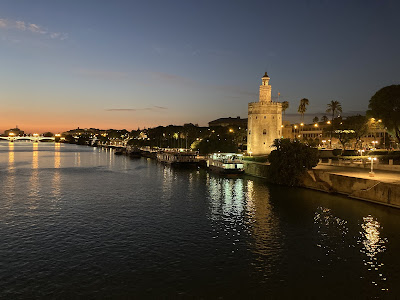He tenido el privilegio de dar un taller con el doctor Fernando Fabiani en el congreso de la Sociedad Española de Medicina de Familia (Semfyc) en Sevilla. Estas reuniones centradas en contenido científico siguen congregando a tutores, residentes y demás. Requieren mucho esfuerzo de preparación, tanto por parte de sus comités científico y organizador como por lo asistentes que aportan sus investigaciones, ponencias y ofertas formativas. Y mucho dinero, que habitualmente pone la industria farmacéutica.
Lo primero que me llamó la atención fue la arquitectura del palacio de congresos de Sevilla, apto para que hubiesen podido acudir tres veces más congresistas de los inscritos, que según me dijeron en algún pasillo fueron unos dos mil que son mucho galeno. Y en esta contemplación estaba cuando me di cuenta de una obviedad, allí faltaba mucha gente. ¿Dónde estaban los estudiantes de medicina? ¿Dónde los profesionales jubilados? ¿Dónde las enfermeras, fisioterapeutas, psicólogos, administrativos sanitarios? ¿Los pacientes, los gestores, los políticos? Quizá piensen que soy ingenuo pero sería factible dedicar un porcentaje de las entradas a invitaciones o a entradas de bajo coste con acceso a las sesiones plenarias y grandes salas que suele tener aforo de sobra. Se podría dedicar un esfuerzo a que estos “invitados” hicieran networking con el resto y aportaran puntos de vista, fundamentales en el actual estado de cosas.
Otra sorpresa fueron los pasillos, uno de los principales activos de este tipo de eventos, donde uno encuentra conocidos en el bar, cuarto de baño, en el mismo pasillo o incluso en el lobby del hotel. Por cierto allí me encontré precisamente con el doctor Rafael Alonso Roca que me hizo una ecocardio con cálculo de Fracción de Eyección allí mismo robando mi corazón para su causa. En el aseo tuve un encuentro con el doctor Bernardino Oliva, del comité científico, que me confirmó mis presunciones, estos grandes congresos son como Trasatlánticos con mucha inercia y poca capacidad de maniobra. Tal vez por eso siempre me sedujeron los más pequeños como los Seminarios de Innovación que coordina Juan Gérvas o la Jornada Vídeos y Salud que durante cuatro ediciones congregó a lo más granado del panorama nacional de creativos sanitarios.
Como el viaje lo planteé en familia no les podré decir nada de las actividades extra congresuales, cenas oficiales y demás. Tan solo que Sevilla es una ciudad que tiene mucho que ofrecer y que sí, inevitablemente termine dando un paseo en coche de caballos.
¿Qué aprendí? Que vivimos tiempos complicados para la Medicina de Familia, que hay profesionales estupendos ahí fuera, que como colectivo seguimos en la inopia sin priorizar a los profesionales inmersos en situaciones de sobrecarga permanente y a los que están al borde del burnout. Y que como Sociedades Científicas, Colegios de Médicos y demás deberíamos tomárnoslo más en serio.
Chronicle of the great congress
I had the privilege of giving a workshop with Dr Fernando Fabiani at the congress of the Spanish Society of Family Medicine (Semfyc) in Seville. These scientifically focused meetings continue to bring together tutors, residents and others. They require a great deal of preparation, both on the part of their scientific and organising committees and by the attendees who contribute their research, papers and training offers. And a lot of money, which is usually provided by the pharmaceutical industry.
The first thing that struck me was the architecture of the Seville conference centre, suitable for three times the number of registered attendees, which I was told in a corridor was around two thousand, which is a lot of doctors. And I was contemplating this when I realised the obvious: there were a lot of people missing: where were the medical students? where were the retired professionals? where were the nurses, physiotherapists, psychologists, health administrators? the patients, the managers, the politicians? You may think I am naïve, but it would be feasible to dedicate a percentage of the entrance fees to invitations or low-cost tickets with access to plenary sessions and large rooms that usually have ample capacity. An effort could be made to allow these "guests" to network with the rest of the participants and contribute their points of view, which are essential in the current state of affairs.
Another surprise were the corridors, one of the main assets of this type of event, where one meets acquaintances in the bar, bathroom, in the same corridor or even in the hotel lobby. By the way, it was there that I met Dr. Rafael Alonso Roca who did an echocardiogram with ejection fraction calculation on the spot, stealing my heart for his cause. In the toilet I had a meeting with Dr. Bernardino Oliva, from the scientific committee, who confirmed my presumptions: these big congresses are like Transatlantic with a lot of inertia and little room for manoeuvre. Perhaps that is why I was always seduced by the smaller ones, such as the Innovation Seminars coordinated by Juan Gérvas or the Videos and Health Conference, which for four editions brought together the best of the national panorama of creative health professionals.
As I planned the trip as a family, I will not be able to tell you anything about the extra-conference activities, official dinners and so on. Just that Seville is a city that has a lot to offer and that, yes, I inevitably ended up taking a horse and carriage ride.
What did I learn? That we are living in complicated times for Family Medicine, that there are great professionals out there, that as a collective we are still in the dark without prioritising the professionals immersed in situations of permanent overload and those who are on the verge of burnout. And that as Scientific Societies, Medical Associations and others we should take it more seriously.
伟大的大会纪事
机器翻译,原谅错误。
我有幸在塞维利亚举行的西班牙家庭医学会(Semfyc)大会上与费尔南多-法比亚尼博士一起举办了一个研讨会。这些以科学为重点的会议继续将导师、居民和其他人聚集在一起。它们需要大量的准备工作,无论是科学和组织委员会,还是提供研究、论文和培训的与会者。还有大量的钱,这些钱通常由制药业提供。
给我留下深刻印象的第一件事是塞维利亚会议中心的建筑,适合三倍于注册人数的与会者,我在一个走廊里被告知,大约有两千人,这是很多医生。我在思考这个问题时,意识到了一个明显的问题:有很多人失踪了:医科学生在哪里? 退休的专业人士在哪里? 护士、物理治疗师、心理学家、卫生管理人员在哪里?你可能认为我很天真,但将一定比例的入场费用于邀请函或低价票,可以进入全体会议和通常有充足容量的大房间,是可行的。可以努力让这些 "客人 "与其他参与者建立联系,并贡献他们的观点,这在目前的状况下是非常重要的。
另一个惊喜是走廊,这是此类活动的主要资产之一,人们在酒吧、浴室、同一条走廊甚至在酒店大堂遇到熟人。顺便说一句,正是在那里,我遇到了拉斐尔-阿隆索-罗卡医生,他当场做了射血分数计算的超声心动图,为他的事业偷走了我的心。在厕所里,我与科学委员会的Bernardino Oliva博士进行了会谈,他证实了我的推测:这些大型大会就像跨大西洋大会,有很多惯性,没有什么回旋余地。也许这就是为什么我总是被一些较小的会议所吸引,例如由胡安-盖尔瓦斯(Juan Gérvas)协调的创新研讨会或视频与健康会议,这四届会议汇集了全国最好的创造性健康专业人士。
由于我是以家庭为单位计划的旅行,我将无法告诉你关于会议之外的活动、官方晚宴等的任何情况。只是,塞维利亚是一个有很多东西可以提供的城市,而且,是的,我不可避免地最后要坐马车了。
我学到了什么?我们生活在全科医学的复杂时代,那里有伟大的专业人员,作为一个集体,我们仍然处于黑暗之中,没有优先考虑那些长期处于超负荷状态的专业人员和那些濒临倦怠的人。而且,作为科学协会、医学协会和其他机构,我们应该更认真地对待它。



No hay comentarios:
Publicar un comentario